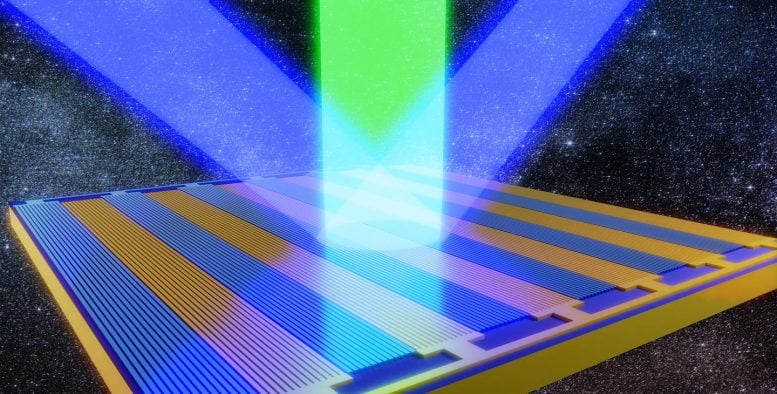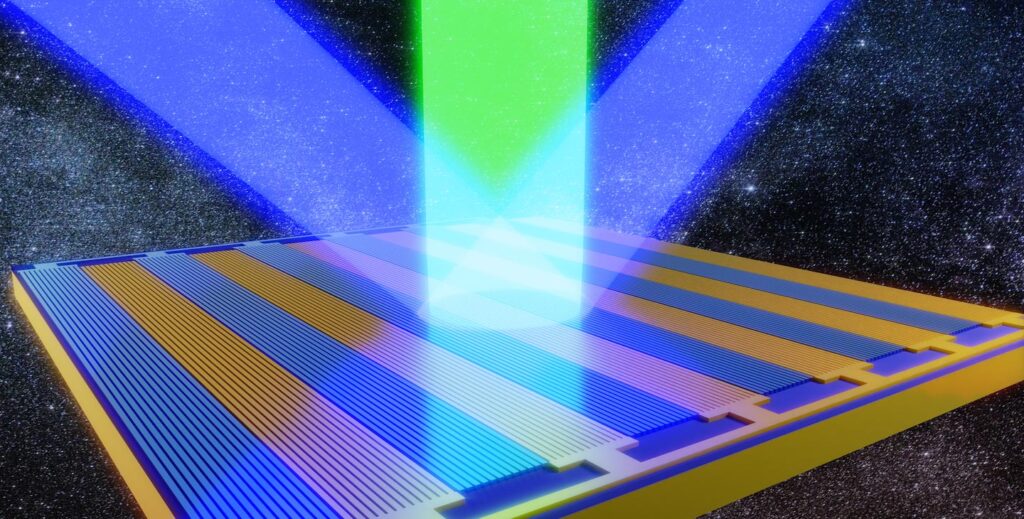A new metasurface developed by Caltech can split a light beam into several channels, enhancing wireless communication and data transmission capabilities at optical frequencies, with potential applications in space communication and LiDAR. Credit: Caltech
Caltech engineers have introduced an innovative metasurface that manipulates light to provide multiple communication channels at optical frequencies.
This technology promises to enhance data transmission in various fields including space communications and LiDAR, moving beyond traditional electronic methods and offering substantial bandwidth improvements.
Revolutionizing Wireless Communication With Metasurfaces
It is a scene many of us are familiar with: You’re working on your laptop at the local coffee shop with maybe a half dozen other laptop users—each of you is trying to load websites or stream high-definition videos, and all are craving more bandwidth. Now imagine that each of you had a dedicated wireless channel for communication that was hundreds of times faster than the Wi-Fi we use today, with hundreds of times more bandwidth. That dream may not be far off thanks to the development of metasurfaces—tiny engineered sheets that can reflect and otherwise direct light in desired ways.
Breakthrough in Optical Metasurface Technology
In a paper published on July 24 in the journal Nature Nanotechnology, a team of Caltech engineers reports building such a metasurface patterned with miniscule tunable antennas capable of reflecting an incoming beam of optical light to create many sidebands, or channels, of different optical frequencies.
“With these metasurfaces, we’ve been able to show that one beam of light comes in, and multiple beams of light go out, each with different optical frequencies and going in different directions,” says Harry Atwater, the Otis Booth Leadership Chair of the Division of Engineering and Applied Science, the Howard Hughes Professor of Applied Physics and Materials Science, and senior author on the new paper. “It’s acting like an entire array of communication channels. And we’ve found a way to do this for free-space signals rather than signals carried on an optical fiber.”
The work points to a promising route for the development of not only a new type of wireless communication channel but also potentially new range-finding technologies and even a novel way to relay larger amounts of data to and from space.

An incident laser beam (green) hits Caltech’s new space-time metasurface and gets modulated by tunable, nanostructured antennas, creating steerable beams of light at different frequencies (blue) that could be used as optical channels for transmitting data on Earth or in space. Credit: Caltech
The Mechanics of Metasurfaces: Beyond Traditional Optics
Co-lead author on the new paper Prachi Thureja, a graduate student in Atwater’s group, says to understand their work, first consider the word “metasurface.” The root, “meta,” comes from a Greek prefix meaning “beyond.” Metasurfaces are designed to go beyond what we can do with conventional bulky optical elements, such as camera or microscope lenses. The multilayer transistor-like devices are engineered with a carefully selected pattern of nanoscale antennas that can reflect, scatter, or otherwise control light. These flat devices can focus light, in the style of a lens, or reflect it, like a mirror, by strategically designing an array of nanoscale elements that modify the way that light responds.
Much previous work with metasurfaces has focused on creating passive devices that have a single light-directing functionality that is fixed in time. In contrast, Atwater’s group focuses on what are known as active metasurfaces. “Now we can apply an external stimulus, such as an array of different voltages, to these devices and tune between different passive functionalities,” says Jared Sisler, also a graduate student in Atwater’s lab and co-lead author on the paper.
In the latest work, the team describes what they call a space-time metasurface that can reflect light in specific directions and also at particular frequencies (a function of time, since frequency is defined as the number of waves that pass a point per second). This metasurface device, the core of which is just 120 microns wide and 120 microns long, operates in reflection mode at optical frequencies typically used for telecommunications, specifically at 1,530 nanometers. This is thousands of times higher than radio frequencies, which means there is much more available bandwidth.
At radio frequencies, electronics can easily steer a beam of light in different directions. This is routinely accomplished by the radar navigation devices used on airplanes. But there are currently no electronic devices that can do this at the much higher optical frequencies. Therefore, the researchers had to try something different, which was to change the properties of the antennas themselves.
Sisler and Thureja created their metasurface to consist of gold antennas, with an underlying electrically tunable semiconductor layer of indium tin oxide. By applying a known voltage profile across the device, they can locally modulate the density of electrons in the semiconductor layer below each antenna, changing its refractive index (the material’s light-bending ability). “By having the spatial configuration of different voltages across the device, we can then redirect the reflected light at specified angles in real time without the need to swap out any bulky components,” Thureja says.
“We have an incident laser hitting our metasurface at a certain frequency, and we modulate the antennas in time with a high-frequency voltage signal. This generates multiple new frequencies, or sidebands, that are carried by the incident laser light and can be used as high-data-rate channels for sending information. On top of this, we still have spatial control, meaning we can choose where each channel goes in space,” explains Sisler. “We are generating frequencies and steering them in space. That’s the space-time component of this metasurface.”
Future Applications and Universal Connectivity
Beyond demonstrating that such a metasurface is capable of splitting and redirecting light at optical frequencies in free space (rather than in optical fibers), the team says the work points to several possible applications. These metasurfaces could be useful in LiDAR applications, the light equivalent of radar, where light is used to capture the depth information from a three-dimensional scene. The ultimate dream is to develop a “universal metasurface” that would create multiple optical channels, each carrying information in different directions in free space.
“If optical metasurfaces become a realizable technology that proliferates, a decade from now you’ll be able to sit in a Starbucks with a bunch of other people on their laptops and instead of each person getting a radio frequency Wi-Fi signal, they will get their own high-fidelity light beam signal,” says Atwater, who is also the director of the Liquid Sunlight Alliance at Caltech. “One metasurface will be able to beam a different frequency to each person.”
The group is collaborating with the Optical Communications Laboratory at JPL, which is working on using optical frequencies rather than radio frequency waves for communicating with space missions because this would enable the ability to send much more data at higher frequencies. “These devices would be perfect for what they’re doing,” says Sisler.
The new paper, “Electrically tunable space-time metasurfaces at optical frequencies,” appears in the July 24 issue of the journal Nature Nanotechnology.
Reference: “Electrically tunable space–time metasurfaces at optical frequencies” by Jared Sisler, Prachi Thureja, Meir Y. Grajower, Ruzan Sokhoyan, Ivy Huang and Harry A. Atwater, 24 July 2024, Nature Nanotechnology.
DOI: 10.1038/s41565-024-01728-9
Additional authors on the paper include Meir Y. Grajower, a former postdoctoral scholar research associate in Atwater’s group; Ruzan Sokhoyan, a nanophotonics research scientist at Caltech; and Ivy Huang, a former Summer Undergraduate Research Fellowship student in Atwater’s group. The work was supported by the Air Force Office of Scientific Research Meta-Imaging MURI, DARPA EXTREME, the Natural Sciences and Engineering Research Council of Canada, and Meta Platforms, Inc.


